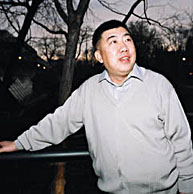Reinventing the wheelchair
Balbir Gill | If you needed a wheelchair to get around, what would you do during the winter in Montreal? We have the new flat-floor buses, ramps, automatic doors and wheelchair-accessible bathrooms. But electric wheelchairs are expensive, not easily portable and have to stay indoors at the first dusting of snow on the ground.

Linghua Kong
Linda Dawn Hammond
Thanks to mechanical engineering doctoral student Linghua Kong, we will see increased mobility for people who use wheelchairs. He has three electric wheelchair designs that are inexpensive and light weight, and one that handles snowy terrain.
"What usually happens is that the pressure [of the wheels] melts the surface of the ice and the water makes a gap between the ice and the rubber, so the wheels don't move. Our design includes a little track, like a tank." Once the wheelchair is inside a building the wheels can be forced down and the track lifts and folds out of the way. Kong expects this wheelchair to be available in about six months.
Last April, Kong and Nadia Bhuiyan, a Concordia engineering professor and recent McGill PhD recipient, won first prize at the 2003 Genesis Awards for their project, "Design of a Cost-Effective Electrical Motor Wheelchair." These awards, presented by the Association de l'industrie des technologies de la santé (AITS) and BIOQuebec, celebrate excellence in health technology and biotechnology.
Kong and Bhuiyan were recognized for their innovative design, which reduces the cost of a motorized wheelchair by half. According to Kong, while a motorized wheelchair currently on the market can cost as much as $2,500, this new version would cost about $1,200.
This wheelchair design takes advantage of current technology by using artificial magnets that are 10 times stronger than naturally occurring ones. The stronger magnet powers a motor small enough to fit inside the wheel, which generates more power for the wheels to turn and enables the wheelchair to go up a steeper incline than before.
Kong's thesis supervisor, Vince Thomson, chair for Manufacturing Automation in the McGill Mechanical Engineering Depart-ment, says Kong's work on the wheelchair design was fueled by his own initiative. "It's something he did out of interest. He's very inquisitive, with a lot of energy."
Kong's recently defended PhD thesis, "Determining the value of processes and information structures on new product development," has practical applications in the workplace. "Linghua was looking at teamwork; how do groups of people contribute their ideas (and therefore you build up the knowledge faster as people co-operate) and, secondly, how can you get more activities done in parallel? The enabling factor is sharing of knowledge and co-operation," Thomson says.
Kong's latest project began a year ago when he founded the company Green Biomedical Technology and Instrument Institute to focus on more innovations to wheelchairs. This company has just designed another adaptation to the wheelchair called the Aider, which Kong expects to be on the market within two months. It is an attachment that fits on the back of the foldable manual wheelchair commonly used by hospitals, turning it into a motorized chair that the patient can drive using a joystick. The motor is portable and uses less expensive batteries than similar wheelchairs.
"The cost is only 1/7th of the cost of similar products that are being sold in the market," says Kong. [Hospitals] told us that 80 percent of the patients can use the joystick. We developed a cheaper device that can be put behind a manual wheelchair so they don't need the nurse to push the patients. Now we're hiring a business person to contact the government department, to use the government channels to sell them."
Kong's online c.v. reveals that he is a descendant of the Chinese philosopher Kong Qiu (a.k.a. Confucius). Kong certainly has his own philosophical ideals. "We don't worry if the product design cannot be sold. Our slogan is to create the value, make the product, reduce the cost and contribute to the society." He expresses his determination that any design improvements his company makes translate into a better price for the consumer as well.
For Kong, it's a simple matter of reciprocity. Through the years that he and his wife, Dingrong Yi, were students at McGill, they both received yearly scholarships from the government. "Every year I got a scholarship from the Quebec government, so maybe this is another reason I want to give benefit to the government because we benefited from the Quebec people. Now I want to contribute to them."
